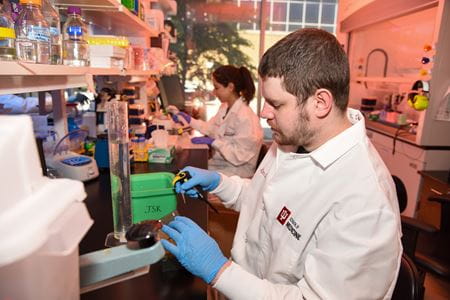INDIANAPOLIS — A new study from researchers at the Indiana University School of Medicine provides a key resource for investigators to better understand disease-specific and sex-specific effects of a gene associated with Alzheimer's disease before the onset of the disease.
The research team, led by Jungsu Kim, PhD, the P. Michael Conneally Professor of Medical and Molecular Genetics, investigated the function of INPP5D — a gene found in the brain’s immune cells and linked genetically with Alzheimer's disease — in healthy male and female mouse brains. They published their findings in Alzheimer's & Dementia: The Journal of the Alzheimer's Association.
Genome-wide studies of Alzheimer's patients identified INPP5D as a risk gene for the disease, and several studies have modeled how the loss of one copy of the gene and reducing the expression of the gene may decrease the risk of developing Alzheimer's disease, finding dramatic but sometimes contradictory effects, Kim said.
Most of what researchers know about INPP5D's normal function comes from studies of the immune cells in blood, not in the brain. The brain's immune cells, microglia, act as the first line of defense against viruses, toxic materials and damaged neurons, such as the buildup of amyloid plaque in Alzheimer’s disease. The team decided to study the loss of the gene in healthy female and male brains, modeling the effects prior to disease onset.
"We simply didn't know what happens in healthy conditions," said Luke C. Dabin, PhD, postdoctoral fellow in medical and molecular genetics and first author on the study. "It's difficult to conclude that changes seen in Alzheimer's disease models are because of an interaction between INPP5D loss and Alzheimer's pathology or just because of INPP5D loss itself. We started this study with the hope that our data will help future experiments prune these effects out of their data and focus on the disease-relevant changes."
Even though the researchers used healthy, non-Alzheimer's disease animal models, they discovered that the normal function of the gene is entangled with mechanisms involved in neurodegenerative diseases, such as Alzheimer's disease, Parkinson's disease, Huntington's disease, ALS and prion diseases.
"This was completely unexpected and suggests that INPP5D could be important in many forms of dementia and is potentially a very promising drug target," Dabin said.
The team found that the loss of the gene also had different effects in females than males, Dabin added. Removing the gene from female animal models led to the collapse of a gene expression module containing more than 5,000 genes; this didn't occur in males.
"We hope this encourages future studies to consider both sexes," Dabin said. "Not only could this lead to the discovery of important sex-specific disease signatures, but also increase translatability to humans."
Additionally, the loss of INPP5D affected the communication between microglia and astrocytes. Astrocytes act as caretakers in the brain, supporting neurons and maintaining the barrier between the brain and the rest of the body. They can also become more "immune-like," Dabin said, and react to triggers like the toxic proteins which build up in Alzheimer's disease brains.
"These findings suggest that when we manipulate genes in microglia, we should pay attention to what astrocytes are doing, too," Dabin said. "This opens the scope of our experiments to a whole new dimension of understanding the disease, as well as moving the spotlight from just microglia to potentially other cells like astrocytes."
About the IU School of Medicine
The IU School of Medicine is the largest medical school in the U.S. and is annually ranked among the top medical schools in the nation by U.S. News & World Report. The school offers high-quality medical education, access to leading medical research and rich campus life in nine Indiana cities, including rural and urban locations consistently recognized for livability. According to the Blue Ridge Institute for Medical Research, the IU School of Medicine ranks No. 13 in 2023 National Institutes of Health funding among all public medical schools in the country.
Writer: Ben Middelkamp, bmiddel@iu.edu
Sources: Jungsu Kim, jk123@iu.edu, and Luke C. Dabin, lcdabin@iu.edu
For more news, visit the IU School of Medicine Newsroom: medicine.iu.edu/news
Follow us on X: @IUMedSchool




